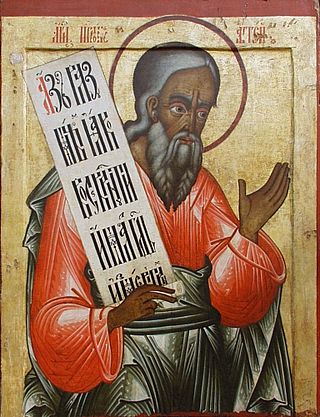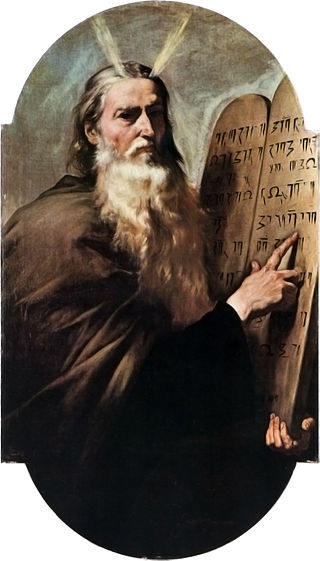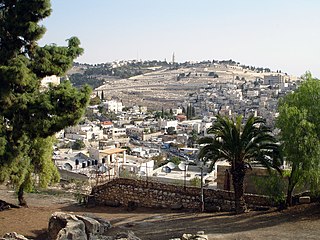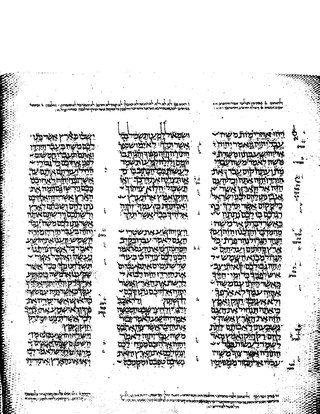Related Research Articles

Ezra or Esdras, also called Ezra the Scribe in Chazalic literature and Ezra the Priest, was an important Jewish scribe (sofer) and priest (kohen) in the early Second Temple period. In Greco-Latin Ezra is called Esdras. His name is probably a shortened Aramaic translation of the Hebrew name עזריהו Azaryahu, "Yah helps". In the Greek Septuagint the name is rendered Ésdrās, from which the Latin name Esdras comes.

Haggai or Aggeus was a Hebrew prophet during the building of the Second Temple in Jerusalem, and one of the twelve minor prophets in the Hebrew Bible and the author of the Book of Haggai. He is known for his prophecy in 520 BCE, commanding the Jews to rebuild the Temple. He was the first of three post-exile prophets from the Neo-Babylonian Exile of the House of Judah, who belonged to the period of Jewish history which began after the return from captivity in Babylon. His name means "my holidays."

The Torah is the compilation of the first five books of the Hebrew Bible, namely the books of Genesis, Exodus, Leviticus, Numbers and Deuteronomy. The Torah is known as the Pentateuch or the Five Books of Moses by Christians. It is also known as the Written Torah in Rabbinical Jewish tradition. If meant for liturgic purposes, it takes the form of a Torah scroll. If in bound book form, it is called Chumash, and is usually printed with the rabbinic commentaries.
Yeshua was a common alternative form of the name Yehoshua in later books of the Hebrew Bible and among Jews of the Second Temple period. The name corresponds to the Greek spelling Iesous (Ἰησοῦς), from which, through the Latin IESVS/Iesus, comes the English spelling Jesus.
The Hivites were one group of descendants of Canaan, son of Ham, according to the Table of Nations in Genesis 10 (10:17). A variety of proposals have been made, but beyond the references in the Bible to Hivites in the land of Canaan, no consensus has been reached about their precise historical identity.

Gibeon was a Canaanite and later an Israelite city, which was located north of Jerusalem. According to Joshua 11:19, the pre-Israelite-conquest inhabitants, the Gibeonites, were Hivites; according to 2 Samuel 21:2, they were Amorites. The remains of Gibeon are located in the southern portion of the Palestinian village of al-Jib.

Nehemiah is the central figure of the Book of Nehemiah, which describes his work in rebuilding Jerusalem during the Second Temple period. He was governor of Persian Judea under Artaxerxes I of Persia.

Mosaic authorship is the Judeo-Christian tradition that the Torah, the first five books of the Hebrew Bible/Old Testament, were dictated by God to Moses. The tradition probably began with the legalistic code of the Book of Deuteronomy and was then gradually extended until Moses, as the central character, came to be regarded not just as the mediator of law but as author of both laws and narrative.

Ophel is the biblical term given to a certain part of a settlement or city that is elevated from its surroundings, and probably means fortified hill or risen area. In the Hebrew Bible, the term is used about two cities: Jerusalem, as in 2 Chronicles 27:3 and 33:14 and Nehemiah 3:26 and 11:21, and Samaria, mentioned in 2 Kings 5:24. The Mesha Stele, written in Moabite, a Canaanite language closely related to Biblical Hebrew, is the only extra-biblical source using the word, also in connection to a fortified place.

The return to Zion is an event recorded in Ezra–Nehemiah of the Hebrew Bible, in which the Jews of the Kingdom of Judah—subjugated by the Neo-Babylonian Empire—were freed from the Babylonian captivity following the Persian conquest of Babylon. In 539 BCE, the Persian king Cyrus the Great issued the Edict of Cyrus allowing the Jews to return to Jerusalem and the Land of Judah, which was made a self-governing Jewish province under the new Persian Empire.
Beth-Anath was mentioned in the Bible as "one of the fenced cities that fell to the lot of Naphtali, and from which the Canaanites were not driven out ."
Ancient Hebrew writings are texts written in Biblical Hebrew using the Paleo-Hebrew alphabet before the destruction of the Second Temple in 70 CE.

Joshua 10 is the tenth chapter of the Book of Joshua in the Hebrew Bible or in the Old Testament of the Christian Bible. According to Jewish tradition the book was attributed to the Joshua, with additions by the high priests Eleazar and Phinehas, but modern scholars view it as part of the Deuteronomistic History, which spans the books of Deuteronomy to 2 Kings, attributed to nationalistic and devotedly Yahwistic writers during the time of the reformer Judean king Josiah in 7th century BCE. This chapter focuses on the conquest of southern part of Canaan by the Israelites under the leadership of Joshua, a part of a section comprising Joshua 5:13–12:24 about the conquest of Canaan.

Ezra 7 is the seventh chapter of the Book of Ezra in the Old Testament of the Christian Bible, or the book of Ezra–Nehemiah in the Hebrew Bible, which treats the book of Ezra and book of Nehemiah as one book. Jewish tradition states that Ezra is the author of Ezra–Nehemiah as well as the Book of Chronicles, but modern scholars generally accept that a compiler from the 5th century BCE is the final author of these books. The section comprising chapters 7 to 10 mainly describes the activities of Ezra the scribe and the priest. This chapter focuses on the commission of Ezra by Artaxerxes I of Persia, and the start of his journey from Babylon to Jerusalem.

Nehemiah 11 is the eleventh chapter of the Book of Nehemiah in the Old Testament of the Christian Bible, or the 21st chapter of the book of Ezra-Nehemiah in the Hebrew Bible, which treats the book of Ezra and the book of Nehemiah as one book. Jewish tradition states that Ezra is the author of Ezra-Nehemiah as well as the Book of Chronicles, but modern scholars generally accept that a compiler from the 5th century BCE is the final author of these books. The chapter describes the repopulation of Jerusalem. Judahites (4-6), Benjamites (7-9), priests (10-14), Levites (15-18), gatekeepers (19) and "the rest of Israel" (20-21). Roles in relation to leadership, maintenance and prayer in the Temple are allocated. The people cast lots and 1 of 10 are to volunteer to live in the city whilst the remainder repopulate the surrounding areas.

Joshua 9 is the ninth chapter of the Book of Joshua in the Hebrew Bible or in the Old Testament of the Christian Bible. According to Jewish tradition the book was attributed to the Joshua, with additions by the high priests Eleazar and Phinehas, but modern scholars view it as part of the Deuteronomistic History, which spans the books of Deuteronomy to 2 Kings, attributed to nationalistic and devotedly Yahwistic writers during the time of the reformer Judean king Josiah in 7th century BC. This chapter focuses on the deception by the people of Gibeon to avoid annihilation by having a treaty with the people of Israel under the leadership of Joshua, a part of a section comprising Joshua 5:13–12:24 about the conquest of Canaan.
References
- Baker, Cynthia M. (2002). Rebuilding the House of Israel: Architectures of Gender in Jewish Antiquity. Stanford University Press. ISBN 978-0-804-74029-6.
- Baumgarten, Joseph M. (1977). "The Exclusion of Netinim and Proselytes in 4Q Florilegium". Studies in Qumran Law. Brill. ISBN 978-9-004-05394-6.
- Chryssides, George D. (2009). The A to Z of Jehovah's Witnesses. Scarecrow Press. ISBN 978-0-810-86891-5.
- Cohen, Shaye J. D. (2010). The Significance of Yavneh and Other Essays in Jewish Hellenism. Mohr Siebeck. ISBN 978-3-161-50375-7.
- Day, John (2007). "Gibeon and the Gibeonites in the Old Testament". In Rezetko, Robert; Lim, Timothy Henry; Aucker, W. Brian (eds.). Reflection and Refraction: Studies in Biblical Historiography in Honour of A. Graeme Auld. Brill. pp. 113–138. ISBN 978-9-004-14512-2.
- Dozeman, Thomas B. (2015). Joshua 1-12: A New Translation with Introduction and Commentary. Yale University Press. ISBN 978-0-300-14975-3.
- Driscoll, James F. (1911). . In Herbermann, Charles (ed.). Catholic Encyclopedia . Vol. 10. New York: Robert Appleton Company.
- Dunham, Kyle C. (2016). The Pious Sage in Job: Eliphaz in the Context of Wisdom Theodicy. Eugene, Oregon: Wipf and Stock. ISBN 978-1-4982-8563-6.
 Executive Committee of the Editorial Board; Jacobs, Joseph (1905). "Nethinim". In Singer, Isidore; et al. (eds.). The Jewish Encyclopedia . Vol. 9. New York: Funk & Wagnalls. p. 233.
Executive Committee of the Editorial Board; Jacobs, Joseph (1905). "Nethinim". In Singer, Isidore; et al. (eds.). The Jewish Encyclopedia . Vol. 9. New York: Funk & Wagnalls. p. 233.- Gordon, Robert P. (2016). Hebrew Bible and Ancient Versions: Selected Essays of Robert P. Gordon. Routledge. ISBN 978-0-754-65617-3.
- Grintz, Jehoshua M. (June 1966). "The Treaty of Joshua with the Gibeonites". Journal of the American Oriental Society. 86 (2): 113–126. doi:10.2307/596424. JSTOR 596424.
- Hezser, Catherine (2005). Jewish Slavery in Antiquity. Oxford University Press. ISBN 978-0-199-28086-5.
- "Nethinim". Net Bible.
- Orlin, Eric, ed. (2015). "Netinim". Routledge Encyclopedia of Ancient Mediterranean Religions. Routledge. ISBN 978-1-134-62552-9.
- Penton, M. James (2015). Apocalypse Delayed: The Story of Jehovah's Witnesses (3rd ed.). University of Toronto Press. ISBN 978-1-442-61605-9.
- Poppers, H. L. (July 1958). "The Declassé in the Babylonian Jewish Community". Jewish Social Studies. 20 (3): 153–179. JSTOR 4465617.
- Strong, James. "H5411 - Nathiyn". Strong's Concordance.
- Taylor, Bernard Alwyn (2009). Analytical lexicon to the Septuagint. Hendrickson. ISBN 978-1-565-63516-6.
- Weinberg, Joel P. (January 1975). "Netînîm und "Söhne der Sklaven Salomos" im 6.—4. Jh. v. u. Z". Zeitschrift für die alttestamentliche Wissenschaft (in German). 87 (3): 355–371. doi:10.1515/zatw.1975.87.3.355. S2CID 170746034.